Contents
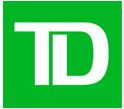 Summary
Summary
- TD is akin to some of my grade school classmates who consistently generated B+/A- grades versus my grades which were a different letter of the alphabet.
- TD shareholders should give thanks to former TD executives who had the foresight to acquire Canada Trust in 2000 and 2 US banks (Banknorth in 2005 and Commerce Bancorp in 2008).
- TD is exposed to the over-indebted Canadian consumer and to a correction in the Canadian housing market. Risk, however, is very well managed and the probability of a correction to the magnitude of that postulated by PAA Research is remote.
- Some investors might be able to make money shorting TD. It just happens to be a tough way to make money. Most investors should just buy, hold, and reinvest the dividends.
All figures are expressed in Canadian dollars.
Introduction
Recently PAA Research (“PAA”) based in Atlanta, Georgia released a report suggesting investors are being presented with an opportunity to profit by shorting (please listen to video) the Canadian banks.
Prior to reading this analysis on The Toronto-Dominion Bank (TSX: TD), you are encouraged to read my recent analysis on The Royal Bank of Canada (TSX: RY) in which I present my take on why shorting the Canadian banks stocks is not a recommended course of action.
Q4 2017 and FY2017 Results
TD’s Q4 and FY2017 results presentation can be found here with supplementary detailed information available here. Readers are also strongly encouraged to read TD’s Q4 News Release to obtain more granularity with respect to certain line items on the financial statements.
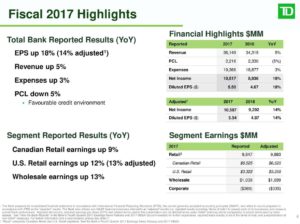

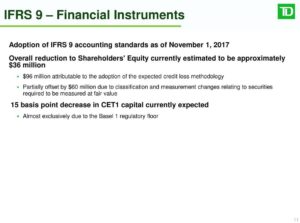
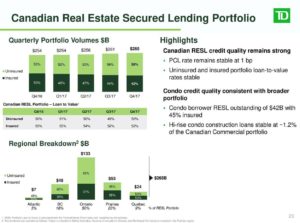
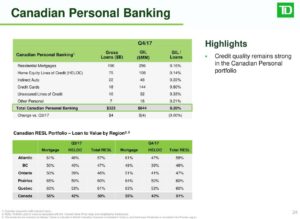 Source: TD's FY2017 and Q4 Results
Source: TD's FY2017 and Q4 Results
FY2018 Outlook
As noted in my other articles in this series about the major Canadian FIs, considerable focus has been placed on the Canadian banks’ exposure to the Canadian consumer and the Canadian housing market.
It is highly probable that real estate sales will weaken in 2018. Recently there has been a surge in home sales in major Canadian markets. This is likely the result of some households speeding up their home buying decision before Canada’s top banking regulator’s (The Office of the Superintendent of Financial Institutions) new uninsured mortgages guidelines take effect January 1, 2018.
While a likely slowdown in real estate lending in Canada in 2018 is a strong possibility, readers should note that TD:
- has multiple stream of income. It generates substantial earnings from its US Retail business line and the Wealth side of its Canadian Retail business line. Wholesale Banking is another area from which TD generates income but the magnitude is much smaller than the aforementioned business lines.
- has the most exposure to the US market of all its Canadian peers. The projected increases in the Fed rate in 2018 and potential tax cuts are expected to positively impact the Bank’s earnings in 2018.
- was expected to take an earnings hit when oil and gas prices took a nosedive just a few short years ago. TD escaped relatively unscathed and judging from the quality of its Canadian portfolio, it appears TD is well positioned to whether the real estate market correction many investors suspect will occur within the next 12 months.
- TD’s current Group Head and Chief Risk Officer was my boss many years ago. He was an extremely astute and conservative banker at the time. I strongly suspect his risk management skills have only improved over the years otherwise he would not be in his current role. I am willing to bet my bottom dollar he is monitoring the bank’s risk exposure like a hawk and am not concerned TD is exceedingly vulnerable to a correction in the Canadian housing market.
The impact of the latest mortgage rule changes in Canada, NAFTA renegotiations, and geopolitical uncertainty could cause some disruption in 2018. Senior management, however, indicated on its November 30, 2017 analyst call that strong momentum from 2017 is expected to carry over to 2018 on the basis that:
- the Canadian and U.S. economies are growing;
- the North American job markets are healthy;
- wages are rising;
- moderate interest rate increases in the US and Canada would positively impact net interest margin.
Unless a major disruption occurs, total bank adjusted EPS growth for 2018 will likely fall within the 7% -10% medium-term target range.
Dividends, Dividend Yield, and Dividend Payout Ratio
TD’s dividend history can be found here. As with the other major Canadian financial institutions, TD froze its quarterly dividend during the Financial Crisis.
The next quarterly $0.60 dividend will be payable toward the end of January 2018 marking the 3 rd consecutive dividend payment at this level. Unlike some of its Canadian counterparts which have been increasing their dividend a couple of times per year, TD has opted to increase its dividend less frequently but at a slightly higher level.
TD’s dividend payout ratio on a reported and an adjusted basis (current, quarterly for the past 2 fiscal years, and annual for the past 3 fiscal years) can be found on page 5 of 90 of the October 31, 2017 Supplementary Financial Information document. Both ratios for FY2017 are sub 44% which is a shade superior to the mid 40s level reported by its peers.
Valuation
The current mean FY2018 adjusted EPS estimate from various brokers is $5.91.
Using the low ($5.74), mean ($5.91), and high ($6.10) adjusted EPS estimates and a $72.43 closing stock price on December 5, 2017 I get a forward adjusted PE of ~12.62, ~12.26, and ~11.87. These valuation levels exceed those of The Canadian Imperial Bank of Commerce (TSX:CM) (~11.24, ~10.79, and ~10.49), The Bank of Nova Scotia (TSX: BNS) (~12.21, ~11.83, and ~11.27) but are lower than those of RY (~12.94, ~12.57, and ~12.14). This is attributed to the analysts’ view that TD’s franchise is superior to that of CM and BNS and slightly inferior to that of RY.
I view the projected adjusted EPS estimates reflected above as reasonable for a franchise of TD’s quality.
Final Thoughts
It would be naive to think the probability of a housing correction in major Canadian markets in 2018 will not occur. If we do get a correction we will undoubtedly see a pullback in TD’s stock price. I do not, however, envision a correction to the extent PAA suggests.
The bank is well diversified and very closely monitors its risk exposure. The bank’s senior management is not operating with heads buried in the sand. They have a far better pulse on their business than me and the vast majority of the readers of this article.
As noted in my previous articles within this series, betting against the Canadian banks is a tough way to make money. In my opinion, I recommend investors think long-term. A buy, hold, and reinvest the dividends strategy can result in a significant increase in wealth over time and with considerably less stress than going short.
I wish you much success on your journey to financial freedom.
Thanks for reading!
Note: I sincerely appreciate the time you took to read this post. As always, please leave any feedback and questions you may have in the “Contact Me Here” section to the right.
Disclaimer: I have no knowledge of your individual circumstances and am not providing individualized advice or recommendations. I encourage you not to make any investment decision without conducting your own research and due diligence. You should also consult your financial advisor about your specific situation.
Disclosure: I am long TD, BNS, CM, and RY.
I wrote this article myself and it expresses my own opinions. I am not receiving compensation for it and have no business relationship with any company whose stock is mentioned in this article.
My Amazon picks.


